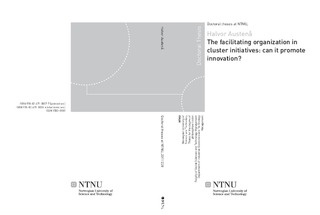| dc.description.abstract | The facilitating organization does the cooperation, network building, policy development and implementation in regional innovation systems initiatives, including for example cluster development, triple helix cooperation, learning regions, and more. The regional innovation systems theories have an analytic value and give policy recommendations for regions that want to become economically successful. The facilitating organization is the meeting point between the regional innovation system theoretical concepts and the regional reality. Regional innovation system initiatives are a constructed social reality, which is built from three different parties with different positions in relation to the initiative: the regional; the national; and the theoretical views.
In the Norwegian context the facilitating organization is usually a project organization but the participants are autonomous actors like industrial companies, universities, research institutes, politicians, and bureaucrats. As such this dissertation argues that the facilitating organization should be studied as a governance network because different actor types outside the normal organizational setup in a region collaborate to influence public policy.
Two main theoretical models are developed to study the facilitating organization as a governance network. The first model characterizes the facilitating organization itself including its governance and its outputs. The outputs create legitimacy for the facilitating organization. The facilitating organization itself is characterized by its identity—that is who it is and what it thinks it should do—and by its capabilities like resources, people, mandates and organizational capabilities. Since the facilitating organization is seen as a governance network the traditional instructional governance of the organization is replaced by a concept called meta-governance. In governance network theories within this theoretical position called the integration position, this metagovernance’s objective is to develop the facilitating organization’s identity and capability. The output is the facilitating organization’s talk, decisions, and actions. This gives the facilitating organization legitimacy that is it gets its existence accepted by its surrounding environment. The second model is used to analyze how different cases develop within the facilitating organization. The development is seen in relation to two axes: first whether the case is coordinated within the organization or falls beyond the organization; and second, whether the facilitating organization is in an action- or a thinking modus while working with the case.
Since the facilitating organization must create its legitimacy towards an inconsistent environment of many stakeholders the output created must—in addition to producing action—also be a pragmatic development of a symbolic accord with its environment. This will lead to a pragmatic connection between talk, decision, and actions of the facilitating organization where it can say one thing, decide another, and do a third to maintain legitimacy towards several stakeholders and itself.
The two theoretical models are demonstrated on an industrial cluster initiative in Kongsberg Norway. This cluster is large by Norwegian standards and has been seen as very successful over the last several decades. The industrial cluster was an important part of a national policy instrument to create a modern technological industry in Norway until 1987. After that the cluster developed as several companies mostly with private ownerships. The main finding on the facilitating organization of the Kongsberg cluster initiative is that it is dominated by two industrial identities partly overlapping but partly with conflicts. The first identity has characteristics from the time the Kongsberg industry was a national political instrument. The second identity is developed after this period with the industry operating in as successful, global, competitive industrial actors.
These two identities are so dominant that activities that are in line with them will be seen as successful and stay within the coordination of the facilitating organization. Activities that are in contrast with either or one or both identities will either be removed or placed at single actors outside the coordination of the facilitating organization. One activity had difficulty to gain legitimacy in both identities at the same time, and is still negotiating to find a good result.
The two identities are so dominant that the national funders of the cluster initiative have little real influence over the developments in the facilitating organization of the Kongsberg cluster. The national funder treats the facilitating organization mostly as a traditional organization and focuses its meta-governance on the capabilities and not the dominating identities. Thus the facilitating organization and the Kongsberg cluster initiative have difficulties in developing outside the framework of its existing identities. A consequence of this is that the activities in the facilitating organization often end up in an action modus without conscious use of thinking and reflection to correct the direction of the activity. This may be a problem because if the facilitating organization is only able to get the industrial cluster to do more of the same, what then is the function of the facilitating organization other than a networking facilitator? More of the same may be a good strategy for the development of Kongsberg industry, but it would probably not need other collaborative actions to implement that strategy.
The proposed models to analyze the facilitating organization as a governance network are tested on a single case. This case, the Kongsberg cluster initiative, has a very strong identity built up over several years. The use of the model on other initiatives may be more immature, and with smaller companies with less documented successes than Kongsberg they may reveal other issues.
The focus on the identity of the facilitating organization in the understanding and development of regional innovation system initiatives may be a key point even for regions with less developed identities | nb_NO |
